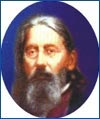Hearts action: feeble, slow; depressed;hands and feet cold.
Pulse frequent, soft, weak, almost imperceptible; slow and full.
Outer Chest
Periodical pains in the pectoral muscles.
Neck Back
Pains from spine to head and shoulders.
Contractive sensation in the right side of the nape.
Pains in the neck, myalgic, mostly in the upper part of the sterno-cleido muscles, back of the parotid glands.
Congestion of the spine; prostration, languor; muscles, Locomotor ataxia. Paraplegia.
Dull aching in the lumbar and sacral region; cannot walk, muscles will not obey.
Upper Limbs
Deep-seated muscular pains in both arms. Palms hot, dry.
Coldness of wrists and hands.
Arms weak, numb.
Lower Limbs
Deep-seated muscular pains in the legs, relieved by motion.
Shooting pains in paroxysms.
Drawing, contracting, crampy pains in the legs, from thighs into toes; worse on motion or walking.
Heaviness, weight; loss of voluntary motion; muscles will not obey the will; calves feel bruised; pain at night.
Feeling when walking, as in a partial luxation of patella.
Coldness of the extremities, especially of the feet, as if in cold water, with anguish and pain in the legs.
Limbs in General
Limbs cold, with oppressed breathing; cold hands and feet.
Deep-seated dull aching in the limbs and joints generally; induced by cold, and attended with loss of motion.
Neuralgic pains in the limbs, as a sequel to scarlatina.
Position etc.
Wants to lie still.
Resting on high pillow, head better.
Sitting erect:, Walking: in open air: Cannot walk: Moving: Motion:, Worse beginning to move, better from continued motion: Fears to remain quiet: Shaking head: Exertion: mental: Lying: with head high: on left side: Riding, sitting erect:. Smoking: Inclining the head: By lifting or turning the patient:.
Nerves
Excessive irritability of mind and body; vascular excitement.
Convulsions from reflex irritation; spasms of one leg.
Puerperal spasms, preceded by great lassitude, dull feeling in the forehead and vertex fulness in the region of the medulla; head feels “big”; heavy with half stupid look; face deep red, speech thick; pulse slow, full; from protracted labor; rigid as uteri; albuminuria.
Tetanic spasms; jaws locked.
Jactitation of the muscles.
Paralysis of motion; muscles will not obey the will, feel bruised. Tingling, prickling, crawling.
Neuralgia. Acute, sudden, darting pains; shooting, tearing along the tracks of the nervous; especially if aggravated by changes in the weather.
Sleep
Yawning, chilly.
Sleeplessness; a wide-awake feeling.
Sleepless from violent itching of face, head and shoulders; sleepless during dentition; face red; also from exhaustion.
As soon as he falls asleep, delirious.
Awakened by headache or colic.
Drowsy, dim sight; a kind of drunken stupor.
Stupor in beginning of fevers; especially with children.
Languid, drowsy, but cannot compose the mind for sleep.
Wakeful or lies in a half awake state, with incoherent talk.
Time
Morning : Forenoon : neuralgic headache (10 A.M.): Afternoon : 4 to 5 P.M. : Evening :,.
Temperature and Weather
Worse in damp weather, before a thunder-storm; south-east wind: Heat of sun or summer : Open air : Changes of weather : Cold: 0,. Warmth : Changes of weather: Cold:,. Warmth : (hot application) :.
Chill Fever Sweat
Chilliness, languid aching in back and limbs; sense of fatigue, desires to avoid all muscular exertion; every afternoon, 4 to 5 P.M.
Chills begin in the hands; chills running up the back; hands and feet cold. Feet cold, with heat of the head and face; headache.
Slight occasional moisture : sweat coming gradually and moderately, always relieving the pains.
Sweats freely from slight exertion.
Typhoid fever, when so-called nervous symptoms predominate.
Low fevers when pulse is slow and by lifting or turning the patient, it becomes accelerated.
Eruptive fevers : especially children, tendency to convulsions at the time of the eruption. Intense fever-heat, erethism, but less restlessness than Aconite; less violence and suddenness of aggravation then Bellad.
Languid; asthenic fever; stupor.
Attacks
Fevers remit or intermit.
Periodical attacks :, Every day at the same hour.
Sides
Right :,, Left : Right to Left :. Below upwards :, Before backwards : Back to front :.
Tissues
Congestions, arterial or venous, with sluggish circulation, Hemorrhages, blood in drops, crimson.
Affects more the nerves of motion; causes muscular prostration through the nerves.
Catarrhs of mucous membranes; watery mucus, never purulent discharges.
Contact Injuries etc.
Pressure :. Riding :.
Skin
Papular eruption, like measles, especially on face.
Skin hot, dry; gastric and nervous fevers.
Erythema, especially in face and neck.
Stages and States
Young persons; children.
Women.
Nervous persons; excitable.
Relationship
Antidotes : Cinchon; Coffea, salt.

